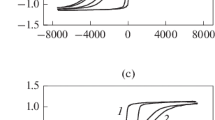Abstract
Fe100−x Ni x alloys of ultrafine particle with the average grain size of about 10 nm were synthesized by mechanically alloying process. The samples were investigated by X-ray diffraction and measurements of the saturation magnetization and coercivity force. Both b. c. c and f. c. c phase exist within a wide range for Fe100−x Ni x , while x≤45. The effective magnetic anisotropy K e was measured by applying the law of approach to saturation. The value of K e decreases with an increase of Ni content. It is noticed that the strain anisotropy makes a large contribution to the magnetic anisotropy. The estimation of grain size leads to the determination of the single domain critical size and domain wall energy. The exchange stiffness and exchange integral deduced from the relationship between the effective magnetic anisotropy and domain wall energy are in agreement with that calculated by other methods.
Similar content being viewed by others
References
Guo Yicheng, Ferromagnetism, People’s Education Publishing House, Bei**g, 1982:96–97 (in Chinese)
Xu shiyue, Chen Hangde, He Zhengming, et al., Dependence of nanocrystalline phase formation and magnetic properties in Fe25 Ni75 on ball milling time, Journal of Shanghai University, 1998, 2(4): 301–304
Hou Denglu, Nie **afu, Luo Helie, Magnetic anisotropy and coercivity of ultrafine iron particles, Journal of Magnetism and Magnetic Materials, 1998, 188:169–172
Ho Kaiyuan, **ong **angyuan, Zhi **g, et al., Measurement of effective magnetic anisotropy of nanocrystalline Fe-Cu-Nb-Si-B soft magnetic alloys, Journal of applied physics, 1993, 74(11):6788–6790
Dong X. L., Zhang Z. D., Zhao X. G., et al., The preparation and characterization of ultrafine Fe-Ni particles, Journal of Materials Research, 1999, 14(2):396–406
Wang J. P., Han D. H., Luo H. L., et al., The magnetic anisotropy of Fe-SiO2 and Fe20Ni80-SiO2 granular solids, Journal of Physics D: Applied Physics, 1994, 27:2002–2008
He Zhengming, Xu Shiyue, Zhang Zhengming, et al., Study on the microstructure and magnetic properties of Fe-Ni ultrafine particles, Journal of Shanghai University (Natural Science), 5(3):257–261 (in Chinese)
Soshin Chikazum, Physics of Ferromagnetism, Oxford Science Publications, 1997: 173–179
Li X. G., Chiba A., Takahashi S., Preparation and magnetic properties of ultra-fine particles of Fe-Ni alloys, Journal of Magnetism and Magnetic Materials, 1997, 170:339–345
Huller K., The spin wave excitations and the temperature dependence of the magnetization in iron, cobalt, nickel and their alloys, Journal of Magnetism and Magnetic Materials, 1986, 61:347–358
Author information
Authors and Affiliations
Additional information
Supported by the Science Foundation of Shanghai Municipal Commission of Education(807965)
About this article
Cite this article
Xu, Sy., He, Zm., Zhang, Zm. et al. The magnetic properties and effective magnetic anisotropy of Fe-Ni ultrafine particles. J. of Shanghai Univ. 4, 155–158 (2000). https://doi.org/10.1007/s11741-000-0016-y
Received:
Revised:
Issue Date:
DOI: https://doi.org/10.1007/s11741-000-0016-y




